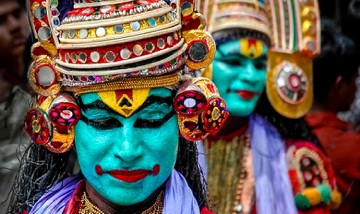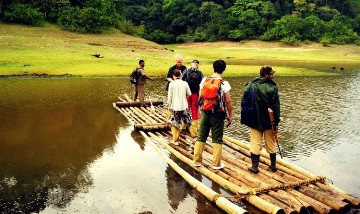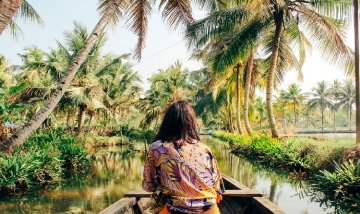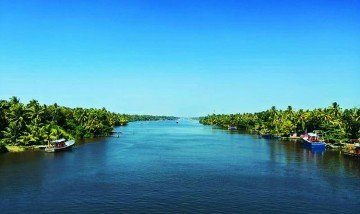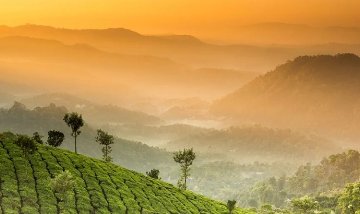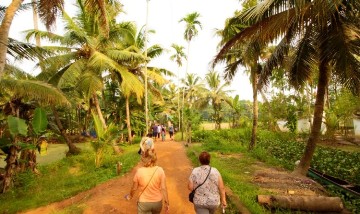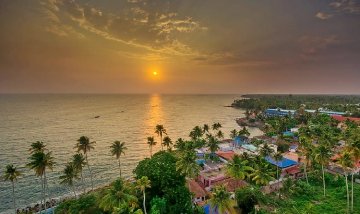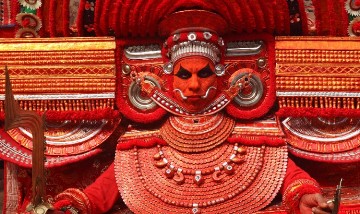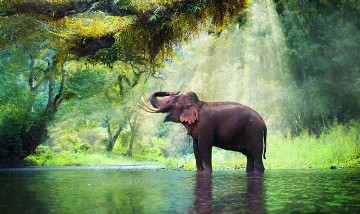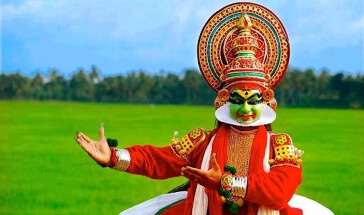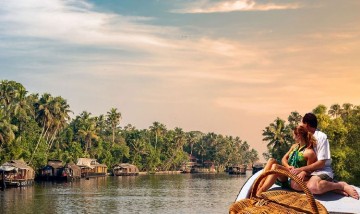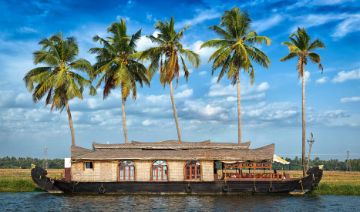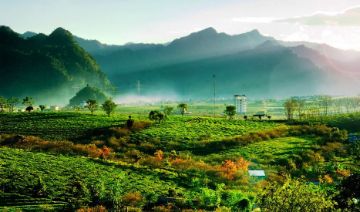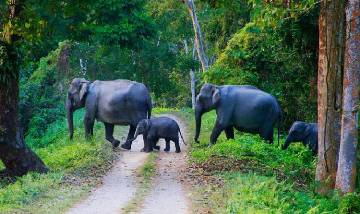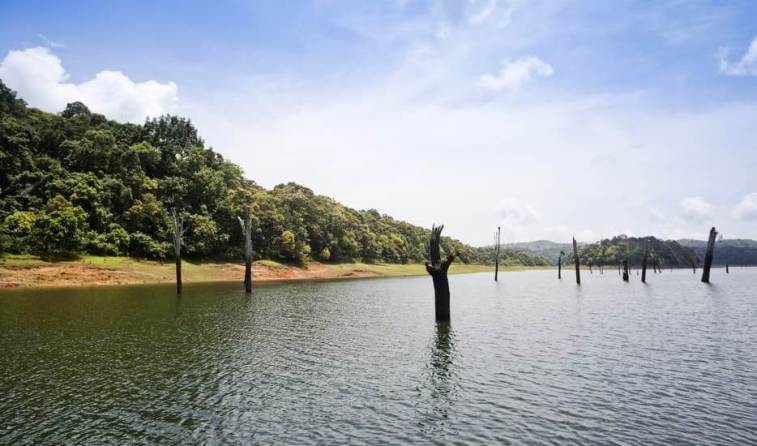Search Destination

Search Destination

Explore Kerala in 2025
Kerala, a state on India's tropical Malabar Coast, has nearly 600km of Arabian Sea shoreline. It's known for its palm-lined beaches and backwaters, a network of canals, and the Western Ghats mountains whose slopes support tea, coffee, and spice plantations as well as wildlife. National parks like Eravikulam and Periyar, plus Wayanad and other sanctuaries, are home to elephants, langur monkeys, and tigers.
Why Kerala is Famous for Tourism?
Kerala, often referred to as 'God’s Own Country', is a destination of a lifetime. The unparalleled beauty of its landscapes, the richness of its culture, and the abundance of natural biodiversity make it a destination that stands out in India. From the serene backwaters of Alleppey and Kumarakom to the lush hill stations like Munnar and Wayanad, Kerala offers a slice of paradise for every type of traveler. The state's vibrant festivals, like Onam and Thrissur Pooram, showcase its rich cultural heritage. Additionally, Kerala's unique Ayurvedic treatments attract wellness seekers from across the globe.
Unique Aspects of Kerala's Culture, Nature, and Attractions
Kerala's culture is a blend of Dravidian and Aryan influences, visible in its classical arts, festivals, and cuisine. The traditional Kathakali dance, known for its elaborate costumes and expressive storytelling, is a must-see. The state's cuisine, characterized by the use of coconut and spices, offers a culinary experience unlike any other.
Nature-wise, Kerala's backwaters are a network of interconnected canals, rivers, lakes, and inlets. A houseboat cruise on these backwaters is a quintessential Kerala experience. The Western Ghats, a biodiversity hotspot, offer opportunities for trekking, bird watching, and wildlife safaris.
Famous Kerala Tours & Itineraries
- The Backwater Experience: A tour focusing on the serene backwaters of Alleppey and Kumarakom, often including a houseboat stay.
- The Hill Station Retreat: Itineraries covering Munnar, Wayanad, and Thekkady, known for their tea and spice plantations, and rich biodiversity.
- Cultural and Heritage Tour: Exploring the historical and cultural landmarks of Kochi, including Fort Kochi, the Jewish Synagogue, and traditional Kathakali performances.
- Ayurvedic Wellness Tour: Focused on rejuvenation and relaxation in one of Kerala's many Ayurvedic resorts.
Key Attractions in Kerala
- Backwaters of Alleppey and Kumarakom: For their unique houseboat experiences.
- Munnar: Known for its tea plantations and scenic beauty.
- Periyar National Park: For wildlife safaris.
- Kochi: Rich in colonial history and cultural diversity.
- Kovalam and Varkala: Famous for their beaches.
- Wayanad: Known for its trekking trails and natural beauty.
Planning Your Kerala Trip Effectively
- Define Your Interests: Decide whether you're more interested in nature, culture, adventure, or relaxation.
- Choose the Right Time: Plan your visit according to the weather and local festivals.
- Book in Advance: Especially for accommodations and experiences like houseboat stays.
- Consider Local Transportation: Plan how you'll move between destinations.
- Include Downtime: Ensure you have time to relax and absorb the local atmosphere.
Ideal Duration for a Kerala Trip
Short Trip (3-4 days): Ideal for a quick tour covering a hill station like Munnar, the backwaters of Alleppey, and a cultural hub like Kochi.
Ideal Trip (5-7 days): Allows for a more relaxed pace, adding destinations like Thekkady for wildlife or Kovalam for beaches.
Moderate Trip (10 days): Offers a comprehensive Kerala experience, including all major destinations and activities.
Extended Trip (2 weeks or more): A comprehensive tour covering most key attractions at a relaxed pace.
Whether 2 Days are Enough for Specific Destinations like Alleppey
While 2 days in Alleppey is short, it's sufficient to experience a houseboat stay and explore the local culture and cuisine. However, a longer stay would allow for a deeper exploration of the backwaters and nearby attractions.
Cost Considerations
Average Costs for a Week-Long Trip, 10-Day Trip, and Variations Based on Travel Style
Week-Long Trip: For a comfortable week-long trip in Kerala, budget around $500-$700 USD. This includes moderate accommodation, daily meals, some guided tours, and internal transportation.
10-Day Trip: For 10 days, a budget of $700-$1000 USD is advisable. This allows for a more relaxed pace, additional activities, and perhaps a few splurges like a luxury houseboat stay.
Travel Style Variations: Budget travelers can manage with around $30-$50 USD per day, staying in hostels and using public transport. Luxury travelers, on the other hand, might spend upwards of $150-$200 USD per day for premium accommodations and private tours.
Comparing Costs with Other Destinations Like Goa
Kerala is generally on par with Goa in terms of costs. However, Goa might have slightly cheaper accommodation options, especially in the off-season. Activities like water sports in Goa can add to the cost, while in Kerala, experiences like houseboat stays and cultural shows might be the major expenses.
Kerala Month by Month: What to Expect
- January to March: Pleasant weather, great for beaches and hill stations.
- April to May: Hot and humid, good for enjoying the less crowded tourist spots.
- June to August: Monsoon season, ideal for Ayurvedic treatments and experiencing the lush greenery.
- September to December: Post-monsoon freshness, perfect for backwater cruises and wildlife spotting.
Best Time to Visit Kerala (And When to Avoid)
The best time to visit Kerala is from September to March. During these months, the weather is pleasantly cool and comfortable for sightseeing. The monsoon season, from June to August, brings heavy rains, making it less ideal for some activities but perfect for Ayurvedic treatments.
Highlighting the Months with Heavy Rain, High Humidity, and the Driest Months
The monsoon season, particularly June and July, experiences heavy rainfall. This period sees lush green landscapes but can be challenging for outdoor activities. The post-monsoon months of August to October are humid. The driest months, ideal for beach visits and hill station tours, are from November to February.
Safety Considerations for Traveling During the Monsoon Season
While the monsoon can be enchanting, it's important to be cautious. Always check weather forecasts, avoid areas prone to landslides, and follow local advice.
Tips for Budget Travel in Kerala
Stay in Homestays or Hostels: These are not only affordable but also offer a chance to experience local culture.
Use Public Transportation: Buses and trains in Kerala are reliable and cost-effective.
Eat Local: Enjoying local cuisine at smaller eateries is both a cultural experience and a money-saver.
Off-Season Travel: Visiting during the off-season can significantly reduce costs in terms of accommodation and activities.
Travel Arrangements
Information on Visas for International Travelers
Most international travelers will need a visa to enter India. E-visas are available for tourists from many countries and are valid for short stays. Always check the latest visa requirements and apply well in advance of your trip.
Transportation and Accommodation
Best Airports for Arriving in Kerala
- Cochin International Airport (COK): The largest and most connected, ideal for destinations like Kochi, Munnar, and Alleppey.
- Trivandrum International Airport (TRV): Best for visiting southern parts like Kovalam and Varkala.
Options for Local Transportation, Including the Best Train Experiences
- Trains: A scenic and affordable way to travel. The Konkan Railway route offers breathtaking views.
- Buses: State-run and private buses connect major towns and cities.
- Taxis and Auto-rickshaws: Ideal for short distances and areas not accessible by bus or train.
Accommodation Choices for Different Budgets
- Budget: Hostels and guesthouses, averaging $10-$20 per night.
- Mid-Range: 3-star hotels or boutique homestays, around $30-$60 per night.
- Luxury: 4-star and 5-star resorts, starting from $100 per night.
Experiencing Kerala
Kerala, with its diverse landscapes and rich cultural heritage, offers a plethora of experiences for travelers. Whether you're there for a short visit or an extended stay, planning your itinerary carefully will ensure you make the most of your time in this enchanting part of India.
Itinerary Suggestions
How to Plan for 5, 7, and 10 Days in Kerala
- 5 Days Itinerary:
- Day 1 & 2: Explore Kochi's historical sites like the Fort Kochi area, the Jewish Synagogue, and Chinese fishing nets. Enjoy a Kathakali dance performance in the evening.
- Day 3 & 4: Head to Alleppey for a houseboat stay in the backwaters. Experience the tranquil waterways and local life.
- Day 5: Visit the tea gardens and spice plantations in Munnar.
- 7 Days Itinerary:
- Follow the 5-day itinerary.
- Day 6: Travel to Thekkady for wildlife spotting in the Periyar National Park.
- Day 7: Explore the local markets and enjoy a traditional Kerala Ayurvedic massage.
- 10 Days Itinerary:
- Include all the above.
- Day 8 & 9: Visit Kovalam for its beautiful beaches and relax by the Arabian Sea.
- Day 10: Explore Trivandrum's historical sites like the Padmanabhaswamy Temple and Napier Museum.
Must-Visit Places and Activities for Different Trip Durations
- Short Trips (5 Days): Focus on Kochi's cultural heritage, Alleppey's backwaters, and Munnar's natural beauty.
- Medium Trips (7 Days): Add Thekkady for wildlife and a taste of Kerala's Ayurvedic treatments.
- Long Trips (10 Days): Include Kovalam for beach relaxation and Trivandrum for historical exploration.
Special Considerations for Solo, Family, and Group Trips
- Groups: Consider private tours for convenience and to accommodate group interests.
- Families: Choose destinations with varied activities to keep all ages engaged. Opt for family-friendly accommodations.
- Solo Travelers: Embrace homestays for a more immersive experience and use public transport for an authentic feel of local life.
Cultural Insights
Appropriate Attire for Kerala
- General: Light, breathable fabrics are ideal due to the humid climate. Cotton is a good choice.
- Religious Sites: Dress modestly when visiting temples and mosques. Women should cover their shoulders and knees, while men should avoid sleeveless tops and shorts.
- Beaches and Resorts: Western swimwear is acceptable at beaches and resorts, but more conservative attire is advisable in rural and public areas.
Understanding Local Customs and Etiquette
- Greeting: The traditional Indian greeting of 'Namaste' with palms pressed together is widely accepted.
- Eating Etiquette: Eating with your hands is common, but always use your right hand as the left is considered unclean.
- Tipping: Tipping is appreciated but not mandatory. A 10% tip in restaurants and for services is customary.
Current Safety Situation in Kerala
Kerala is generally considered a safe destination for travelers. However, it's always wise to stay informed about current local news, especially regarding weather conditions during the monsoon season.
Health and Safety Tips for Travelers
- Vaccinations: Ensure routine vaccinations are up to date. Hepatitis A and Typhoid vaccinations are recommended.
- Water Safety: Drink bottled or purified water to avoid waterborne diseases.
- Mosquito Protection: Use mosquito repellent and wear long-sleeved clothing, especially in the evenings, to prevent mosquito-borne diseases like dengue.
- Travel Insurance: Always travel with comprehensive health insurance that covers medical emergencies.
Kerala Tours & Itineraries
Best of Kerala in 10 Days
9 N - 10 D
Kochi - Kodanad – Munnar – Thekkady - Periyar - Alleppey – Mararikulam - Kochi
8 Days - Kerala Tour Itinerary
7 N - 8 D
Cochin - Munnar - Thekaddy - Alleppey - Kovalam - Kanyakumari - Trivandrum
12 Days - Best of Kerala (Culture to Nature) Tour
11 N - 12 D
Cochin - Athirapally - Munnar - Thekkady - Kumarakom - Alleppey - Kovalam - Kanyakumari - Trivandrum
8-Day Kerala Family Tour (Hills, Backwater, Beaches)
7 N - 8 D
Cochin - Munnar - Thekaddy - Alleppey - Kovalam - Kanyakumari - Trivandrum
6 Days Kerala Beach Vacation (Kanyakumari Kovalam & Varkala)
5 N - 6 D
Trivandrum - Kanyakumari - Kovalam - Varkala - Trivandrum
6 Days Kerala Tour Package
5 N - 6 D
Cochin - Munnar - Thekkady (Periyar) - Alleppey - Houseboat - Cochin
Kerala Destinations
Kerala Article
- Top Places Kerala
- Kerala Street Food
- Top Hill Stations in Kerala
- Shopping Guide Kerala
- Kerala Festival and Events
- Kerala Backwater Destinations
- Kerala Famous Temples
- Kerala Art and Dance Forms
- Things to do in Kerala Honeymoon
- What to do in Kerala in February
- Kerala Popular Beaches
- Ayurveda spa in Kerala
- Top Reasons to Visit Alleppey
- Kerala Historical Places
- Onam Festival Kerala
- Kerala Traditional Food Dishes
- Thrissur Pooram Festival Kerala
- Arattu Festival, Kerala
- View More [+]
FAQs Kerala Tours

Q.Is Kerala suitable for first-time travellers to India?
A. Absolutely! Kerala is often recommended for first-time visitors due to its relatively relaxed pace, friendly locals, and well-developed tourist infrastructure. It's a great introduction to the diverse culture and landscapes of India.
Q. Can I find vegetarian or vegan food easily in Kerala?
A.Yes, Kerala offers a wide range of vegetarian and vegan options. The state's cuisine includes many dishes based on rice, coconut, and vegetables. Do try the traditional 'Sadya', a vegetarian feast served on a banana leaf.
Q. What are the must-try local foods in Kerala?
A.Kerala's cuisine is rich and varied. Don't miss the seafood, especially the 'Karimeen Pollichathu' (fish wrapped in banana leaves and grilled). Also, try the 'Appam' with 'Stew', 'Puttu' with 'Kadala Curry', and the sweet 'Payasam'.
Q. Which are the famous festivals and events in Kerala?
A. Kerala is a popular South Indian state which is known for its magnificent cultural festivals. Some of the most popular festivals of Kerala are Onam, Temple Festivals, Theyyam, AttukalPongala, Kerala Boat Festivals, Makaravilakku, Thrissur Pooram ,MahaShivarathri and many more.
Q. Is it easy to get around Kerala without knowing Malayalam?
A. Yes, it is. English is widely spoken, especially in tourist areas, and most signboards are in English. Locals are generally helpful and accommodating to tourists.
Q. What are the best souvenirs to bring back from Kerala?
A. Popular souvenirs include Kerala spices, tea and coffee, traditional Kathakali masks, handloom fabrics like Kasavu sarees, and coir products.
Q. Are there any specific cultural norms I should be aware of?
A.Respect local customs and traditions. Dress modestly, especially when visiting religious sites. It's also polite to remove your shoes before entering someone's home or a place of worship.
Q. What should I pack for a trip to Kerala?
A. Pack light cotton clothing, a good sunscreen, a hat, comfortable footwear, mosquito repellent, and an umbrella or raincoat if traveling during the monsoon season.
Q. How can I stay connected? Is Wi-Fi widely available?
A. Most hotels, cafes, and restaurants offer free Wi-Fi. It's also easy to buy a local SIM card for mobile data, which is quite affordable.
Q. Are cameras allowed inside the temples in Kerala?
A. Most of the temples do not allow cameras and mobile phones inside the temple premises. You can put these in rented lockers before entering the temple.
Q. What are the best activities for adventure seekers in Kerala?
A. Kerala offers trekking in the Western Ghats, wildlife safaris in Thekkady, bamboo rafting in Periyar River, and water sports in Varkala and Kovalam.
Q.Can I use credit cards, or do I need local currency?
A. Credit cards are accepted in most hotels, restaurants, and shops in urban areas. However, it's good to have some local currency (Indian Rupees) for smaller purchases and in rural areas.
Q. What is the best way to experience Kerala's backwaters?
A. A houseboat stay in Alleppey or Kumarakom offers an immersive experience. You can also take a canoe or a smaller boat for a more intimate exploration of the backwaters.
Q. Is there a dress code to enter temples in Kerala?
A. Some temples only allow traditional dress codes. For example, Sree Padmanabha Swamy Temple in Thiruvananthapuram follows a strict dress code, Dhoti or Mundu (can be available near the temple on rent) and saree or skirt & blouse for women.
Q. What are the famous honeymoon destinations in Kerala?
A. Some of the best honeymoon destinations in Kerala are Munnar, Wayanad, Bekal, Kumarakom, Poovar, Kovalam and Vagamon etc.
